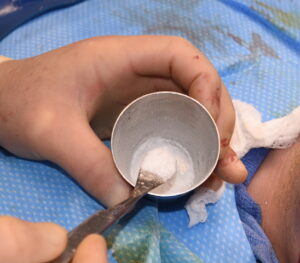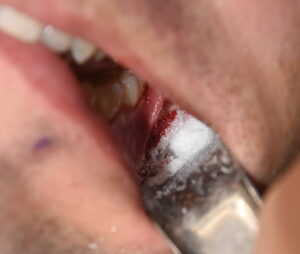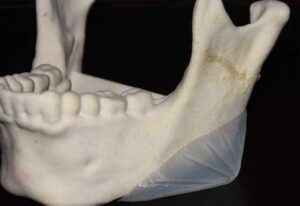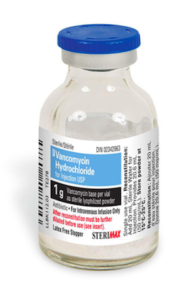
While numerous type of facial implants are placed through intraoral incisions (e.g., cheek and chin implants), those that involve augmentation of the jaw angle area are placed far back into the mouth.Through vestibular incisions at the level of the second and third lower molars getting an implant back to and through it inevitably exposes the implant to greater intraoral contamination. This combined with having incisions right next to the primary chewing surfaces of the upper and lower molars places food debris over and around these healing incisions. As a result the risk of infection in jaw angle and jawline implants is higher than any other type of facial implant.
With the knowledge of this increased infection risk I use a wide variety of intra- and postoperative strategies to prevent it. Such strategies include intraoperative IV and postoperative oral antibiotics, intraoperative skin and oral prep solutions, antibiotic irrigation of the pockets before implant placement and implant sterilization prior to placement. But even these extensive strategies do not provide complete assurance that no infection will occur.
One additional strategy is the use of antibiotic powders placed directly into the implantation site. While the implant may be washed in an antibiotic and other solutions (e.g., Phase One) and the pocket irrigated out similarly, the implant’s surface can not absorb or be impregnated with antibiotics. Thus the only way to assure antibiotic levels around the implant is by the direct placement of antibiotic powders.


There is no absolute assurance that any intraoperative technique can completely eliminate the risk of an implant infection. It would be ideal if the jaw implant itself could be loaded or had antibiotics incorporated into it but that it not possible with most implant materials. Thus the direct application of a powdered form of antibiotic is the most likely to be maintained around the implant once the wound is closed. How long such antibiotics will remain active is not known.
Dr. Barry Eppley
Indianapolis, Indiana





